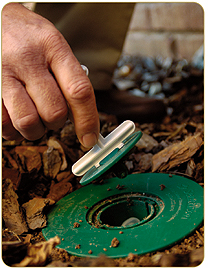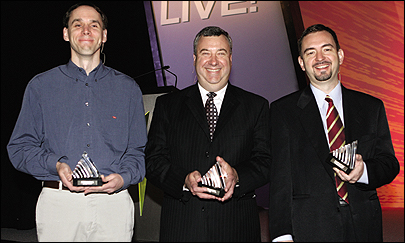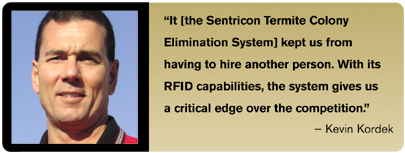Jun 01, 2007On May 2, 2007, RFID Journal presented the first-ever RFID Journal Awards for outstanding achievement in radio frequency identification technology, at RFID Journal LIVE! 2007, our fifth annual conference and exhibition. Dow Agrosciences was the winner for Most Innovative Use of RFID.

Dow AgroSciences, a wholly owned subsidiary of Midland, Mich.-based Dow Chemical Co., offers an RFID-powered termite-detection system that promises to cut costs by helping pest-control technicians find and eradicate termites faster and more efficiently. The Sentricon Termite Colony Elimination System features conically shaped plastic detection stations that are designed to lure and trap termites. The devices are inserted into the ground around a building's perimeter. While operating, the stations are periodically visited by technicians—anywhere from once a month to once a quarter—who scan the units with an RFID interrogator to determine their operational condition: empty, hosting termites or broken. "What drove Dow AgroSciences to RFID was trying to find a better mousetrap, so to speak," says Andy Wurtz, Dow AgroSciences' Sentricon project leader.
Walk and Wave
Dow AgroSciences' RFID termite detection system is based on an earlier version of Sentricon that required technicians to manually open each station, scan a bar code on the device's cap and then manually record the station's condition. "What RFID does for you is that you can walk along with your reader and wave it over the top of the station," says Wurtz. The technician then sees either a red or green light. A green light means everything is OK, and the technician can move on to the next station. "A red light means that you need to open the station and inspect it," says Wurtz. "It may mean you have termites in there, or that the station needs to be serviced due to deterioration, age or some other problem."
Each Sentricon station incorporates a low-frequency 125 kHz RFID tag. The tag is designed to last at least four years in almost any type of outdoor environment. Based on a custom design, the tag uses an RFID chip from semiconductor maker Atmel. The tags are produced for Dow AgroSciences by a contract electronics manufacturer in Michigan. The same manufacturer is also responsible for repairing and designing updates to the RFID interrogator, which is a custom design. "It looks basically like a metal detector," Wurtz says.
Inside the station, the tag is linked to a circuit breaker connected to a termite-sensing element. "If the breaker is tripped, it's likely to be an event where there are termites in there," says Wurtz. The sensing element is made of a type of wood-based paper that termites find particularly scrumptious. When they eat through the paper element, which was designed by a consultant with input from Dow AgroSciences, the circuit is tripped. "So if they get in there, and they eat it, that will give you a red light," says Wurtz.

Other conditions inside the station can also cause the circuit breaker to trip and generate a red light on the interrogator. "You might get ants in there, or it might get really wet in there and you get mold," says Wurtz. "The red light is simply an indicator to the technician that there's a condition that needs investigating."
Stations that are found infested with termites are loaded with termite-eliminating bait. The bait contains a slow-acting poison—noviflumuron—that gives the termites enough time to travel back to their nest and tell all their friends and relatives about where to find the good food. What the termites don't know is that the technician has already installed additional stations, each containing more of the poisoned bait, near the original device. The goal is to get termites to feast on the poisoned bait in sufficient quantities so that the main infestation—in the home or other structure—is gradually eliminated.
Besides alerting technicians to the presence of termites and system malfunctions, the RFID technology also helps automate a number of vital business tasks. The unique tag data associated with each station is collected by external software for tracking and billing purposes. The data also helps pest control providers meet regulatory and quality requirements by proving that a technician did indeed visit the site and did install bait into stations infested by termites. "Data is uploaded into a handheld device, like a PDA," says Wurtz. "Then that data is further uploaded to third-party software, where it's used for billing and inventory tracking."
Dow AgroSciences relies on three third-party software suppliers—Marathon Data Systems, Service Pro and FMC. The RFID interrogators, which Dow AgroSciences provides, have a data port that sends station data to the handheld devices. Each customer is allowed to choose the third-party provider that best meets its needs for data collection, billing and other parameters.
To ensure that quality and regulatory requirements are met, Dow AgroSciences offers its system to only a small percentage of pest management professionals. Dow AgroSciences also shoulders the task of training the technicians who install and service the Sentricon system. "We have training materials that are available—like DVDs—and our sales reps will go out and train new customers," Wurtz says. "They can do it on-site." To help authorized service providers quickly train new hires without a visit from a Dow AgroSciences representative, the company also offers a package of standardized training materials. "There's a lot of turnover in the industry," Wurtz says.
The concept of adding RFID to the Sentricon system originated in Dow AgroSciences' research and development department. But after tackling some preliminary design work, the project's managers realized they would benefit from outside RFID expertise. "Dow is committed to utilizing best practices and strategic partnerships that enable and accelerate innovation," Wurtz says. "Dow AgroSciences recognized that its R&D group is charged with scientific, biology-type projects and would benefit greatly from a collaborative effort with an outside partner."
The enhanced Sentricon system was designed to include a minimum 8-inch RFID read range. Adverse environmental conditions, such as heavy rain or fog, can degrade the read range, but the system still functions sufficiently under most conditions, Wurtz says. Termites are inactive in cold weather, so low-temperature performance is not crucial.
The system was laboratory tested to ensure that both the tag and the interrogator functioned under everyday operating conditions. Once the system was optimized in the lab, the project proceeded to field trials. The trials helped the project's managers identify a number of factors that shaped the system's final construction. Most notably, the managers discovered that the tag had to be completely waterproofed to reliably function in what is an innately wet environment.
"They're out there every day," Wurtz says. "It may be raining, cold or hot—they have to work across a wide range of conditions."
Wurtz says the trials proved that RFID could be successfully and repeatedly used to indicate the presence or absence of termites inside modified Sentricon stations. The trials also helped Dow and a consultant define the interrogator's key design parameters, such as low weight, good physical balance and durable construction.
As the trials continued, they also uncovered weaknesses in the technology. One of the performance challenges encountered was unreliable readings caused by excessive moisture entering the station. Testing discovered that the moisture generated an immediate 20 percent no-read rate, which increased over time. A Dow AgroSciences packaging engineer worked with the tag contract manufacturer to waterproof the tags. The solution was to fill the existing plastic tag housing with potting material, increasing the tag read rate to 99.5 percent.
With the field trial completed, Dow AgroSciences began adding RFID technology to selected Sentricon stations in 2002. The company continued fine-tuning the system over the next few years, with a final, optimized version entering production in 2005. Dow AgroSciences is continuing to work on the technology, using field results to adjust and improve its performance and usability. In March, it launched an updated interrogator design.
As intended, the RFID feature brought added efficiency and productivity to pest-control providers using the Sentricon system. "Time is money for our authorized operators," Wurtz says. "A guy having to get down on his hands and knees to physically examine each station takes a lot longer than the guy who goes around with an RFID reader and only has to stop once or twice."
Adding RFID to Sentricon stations increased operator efficiency by 67 percent, Wurtz says. He notes that before RFID became available, a typical site inspection took about 20 minutes. With the RFID-enabled Sentricon, inspection time has been slashed to six minutes. The narrower time frame allows a technician to cover several more properties every day. "Instead of being able to do 12 structures a day," says Wurtz, "they can now do 20."
But Dow AgroSciences still had to convince its authorized operators that the technology was worth adopting. With the addition of RFID technology increasing Sentricon costs, more than a few operators gulped hard. Many operators, such as Kevin Kordek, president of A-Active Termite & Pest Control in Virginia Beach, Va., weren't sure that RFID was anything more than an expensive new gadget that would kill profits even faster than termites.
"I was not onboard 100 percent, because I looked at it as an additional expense to fix a system that was already working," Kordek says. "Of course, I never stopped to think that maybe the old system wasn't working as well as it could."
Kordek changed his attitude during an RFID briefing Dow AgroSciences held with its authorized operators. After studying the system and examining its operation and potential rewards, he realized that RFID not only signaled an improvement over the existing Sentricon technology but also had the potential to revolutionize his business by boosting productivity and cutting costs.
"It was almost an epiphany," he says. "All of a sudden, it didn't hurt anymore."
Kordek's instincts proved correct. He says the RFID technology now saves his business about $35,000 to $40,000 per year. "It kept us from having to hire another person," he says. "With its RFID capabilities, the system gives us a critical edge over the competition."
Kordek now believes that RFID is ideally suited for termite detection and eradication because of the need to efficiently monitor devices spread over a wide area. "Termites continuously forage, looking for new food resources to sustain the colony," Kordek says. "They don't just feed on your house in one location."
A-Active began using the original Sentricon system, based on bar codes, in 1995, seven years before the RFID version was released. "The first time, we didn't even have a bar-code reader," Kordek recalls. "We had to number the stations and make a list, writing down the bar-code numbers." Although the old bar-code version marked a major improvement over traditional traps and visual detection, RFID has brought termite detection to a yet higher level. "It helps us to do our job better," Kordek says, "which is good news for our customers and bad news for the termites."
Wurtz believes that the Sentricon project proves that RFID's usefulness extends far beyond conventional tracking applications. "The idea of using RFID to detect termites was novel," he says. "It shows that RFID can be applied to a wide range of situations."

The Other Winners
Read about the other RFID Journal Award winners by clicking the links below:
• Hewlett-Packard Brazil for best RFID implementation (see Keeping Tabs on Printers)
• DHL for best use of RFID in a service (see A Prescription for Spoiled Drugs)
Like Dow's project, each story is unique, highlighting the many different ways RFID technology can be implemented. Each shows how RFID can be used profitably today, and each will likely inspire end users to deploy RFID in new ways to create real business value.


